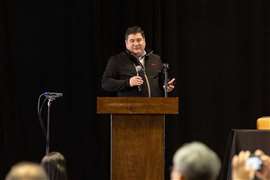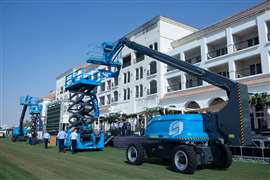New horizons in North America

The sun dips below the horizon at an Orlando, Florida-based Ritchie Bros. auction.
The North American market is back on track following a rough ride over recent years, but the landscape has changed somewhat, and the way is clear for niche products to make their mark. Euan Youdale reports.
The March/April issue of AI JLG’s president Frank Nerenhausen spoke about the positive growth now found in the North American access market thanks to non-residential spending and the profitable energy sector. He said, “Housing is still not at a normal pace but projections for growth for 2014 are quite robust and I think we are still in the early stages of seeing non-residential spending increase; so you put those altogether and you have a fairly positive runway for 2014 and beyond. Then you have the energy sector which kicks in on top of that.”
Concerning investment plans of the big rental companies in North America, Mr Nerenhausen added, “Their cap-ex is perhaps flattish to slightly increasing year-over-year but there is some growth capital starting to move into the mix.”
Ron Defeo said at the Terex press conference at ConExpo that while the company as a whole had a difficult year in 2013, the AWP segment had seen impressive growth. In North America, he said, “We are coming back to substantial annual growth. We all remember the steep financial cliff, but what comes down usually comes back up, and we are nearly back to the performance levels of 2007/2008.” This is certainly true in the AWP segment.
Brad Boehler, Skyjack president, agrees, “In our industry, North America is booming. Growth is at about the same as last year and we should be looking at double digit growth on sales. “It is residential that that drives everything around it. Non-residential is inching forward and I predict we will have significant growth in the next three years.”
Haulotte Group will be looking to capitalise on this with a much stronger showing in the US. At ConExpo it said the time was right thanks to an overall 2.6% GDP growth expected in North America this year, translating into 7% growth for the construction sector. It says the AWP market grew 15% last year, compared to 2012, while Haulotte’s growth was 12% for the same period. The French manufacturer has between 1% and 10% of the market share depending on where you are: its presence east of the Mississippi is much stronger than in the west. In 2014 it is aiming to have 100 territory coverage thanks partly to better service offerings, including spare parts.
New openings
Also looking to make their mark in North America are niche products like crawler mounted and large truck mounted platforms. They were once overlooked in the continent, but since the economic downturn, there has been a change of heart concerning these products and others.
Oil & Steel is working to grow its presence in both these areas. It introduced two new crawler mounted platforms into the North American market at ConExpo 2014. The Italian company said it was also planning to launch a 69 ft truck mount, the Scorpian 69, in Northern America this year in a joint venture with a Wisconsin-based engineering company.
Giovanni Tacconi, sales director at Oil & Steel said, “Tracked platforms are still niche in North America, but it’s a growing market compared to Europe and other markets. Europe has almost reached saturation point, whereas USA is growing.” He adds the North American market is growing 15% a year. “Crawlers are taking over from self propelled booms that cannot take the ground pressure and in small spaces. A crawler weighs 2 to 3 tonnes, whereas a similar self-propelled machine can weigh 7 tonnes.”
Jeffrey Burruano, director of sales at US importer and distributor for Platform Basket and Ommelift agrees with this view of the crawler market. “We started six years ago and since then sales have increased significantly. The product is gaining more acceptance and becoming more mainstream.”
Its latest product aimed at the US markets is a machine named Arborist for Arborists and is a stripped down version of a Platform Basket 34.5, with a 73 ft platform height. As the name suggests it is aimed at the significant tree surgery industry in the US, particularly American Ash, which is going through a major die-out. “We see exponential growth.”
Scott Reynolds, president at Teupen USA, says the North American market for tracked platforms is still developing. “There is a tremendous increase in enthusiasm for our product range from direct sales and rental. It’s all about a steady increase in realisation about this product rather than using more traditional rubber-tyred machines or scaffolding, for example.”
“Our growth is not because of the economic rise but because people require these types of machines more,” adds Mr Reynolds. To demonstrate this the company has just added two key account managers to Seattle and Charlotte in the US. Platform Basket also launched its 33 m model in to the US last year, while Omme introduced the 47 m working height hybrid Omme 4200 earlier this year. “The hybrid’s future is secured. It allows for a universal lift concept, of a single machine being used indoors and outdoors. Using equipment with smaller dimensions and greater profitability is an advantage. We hope a machine like this will replace other lifts.”
The hybrid’s potential is also vaunted in other product types. At the Terex press conference at ConExpo, its AWP segment’s president Matt Fearon said hybrid products were becoming increasingly popular. “There is an increasing demand in hybrid as Tier 4 comes in.” He added that efficient and powerful drives would mean that the operator could easily switch to DC mode. With this in mind, the same piece of access equipment can stay on site from beginning to end. In January Genie introduced its bi-energy, hybrid, rough terrain scissor lift series. The BE69 series includes three models: the 26 ft GS-2669, 33 ft GS-3369 and the 40 ft GS-4069. The machines have an on-board generator.
Electric future
The attributes of purely electric products are being recognised too. For an example see Skyjack’s all electric SJ6832 RTE scissor lift in the Scissors feature which is also available on www.khl.com.
Continuing on the scissor theme, PB Lift Technique has launched its 22 m S225-12ES scissor into the North American market through distributor ReachMaster. It is aimed at another once niche market, the high bay warehouse, which is becoming increasingly common. “We have seen a very positive reaction from the market. High bay facilities are more and more common with narrow isles that, for example, have sprinkler systems incorporated.” The company is hoping to sell 10-15 units in North America this year.
Staying with scissors, and at the other end of the market, Custom Equipment, which produced its Hybrid-Lift brand of low level access scissors, is expecting the North American market to show more interest in the low level area. Steve Kissinger, company president, says, “The US market is becoming good again, there’s steady growth with a 40% increase on last year for us.” The company will be actively seeking expansion in the region by adding to its direct sales team network.
JLG agrees with this philosophy and has introduced a new series of low level access products with the LiftPod FT140, initially aimed at the US market. Topping the LiftPod range, it offers a platform height if 14 ft and a 20 ft working height. The FT140 was on show at ConExpo and is powered by a new dual 36V lithium-ion battery system and has a work tray holding up to 33 pounds of tools and materials, with a total platform capacity of 330 pounds. “The FT140 offers an affordable AWP solution to workplace height challenges, especially when compared to traditional access lifts,” said Randy Marzicola, JLG Industries director of channel development.
Dingli has been around in the US for 10 years with its pusharound stock picker products but now it’s heading into North America with gusto. The Chinese manufacturer was exhibiting its scissor and vertical mast products in North America for the first time at ConExpo and is actively seeking a distributor. So far the manufacturer has not sold any of these products in North America. But with the right dealer it hopes to sell up to 1000 units there in the next two years. In comparison, the company said it has more than 3000 scissors in Europe.
Once those two product lines have been established, the company said it would introduce self propelled booms for direct sale into the US.
Truck mounts
As mentioned, the truck mounted sector is also on the rise in the US. Oil & Steel has a joint venture to produce a 22 m non-insulated telescopic model in the third quarter of this year for sign hanging and maintenance. “It’s a market that will be good for the future. The tendency here in the US is to have big platforms, but with emissions, the smaller truck units will be popular, like in Europe,” says Mr Tacconi. The telescopic line will be broadened with a 30 model.
Speaking of larger trucks the company will also introduce a non-insulated 69 m model, the Scorpion 69, on a 7 tonne truck. It will be aimed at signs, trees, maintenance and all applications in which insulation is not needed. Mr Tacconi says the trend will be towards using lighter trucks and moving away from the traditional insulated booms where they are not necessary, as they are much more expensive. “There is no need to spend so much on a fibreglass machine when 90% of the time you do not need insulated.” Oil & Steel will use high tensile steel on its new 30 m boom to make it lighter.
Certainly, all the relevant US manufacturers are expanding their offerings when it comes to truck mounts. Elliot Equipment has this year launched the E160, its tallest aerial platform. At over 150 ft working height the platform can also be fixed to tracks for Arctic work. It has been designed for one of the biggest sources of work for truck mounts in North America, namely the electric transmission industry, among other applications.
It has less weight and more reach and more flexibility for getting in and out of jobsites, said the company. One such advantage is that it’s Federal bridge legal, which means that it can travel on interstate highways without permit, although that doesn’t apply to off-highway and city roads.
This is another example of how platforms are eating into the crane market. In the past Elliott cranes used basket attachments, but they were regulated to ANSI B30.5, which states that a test weight has to be lifted to the desired height and outreach before a person can use the basket. The E160, on the other hand, has been tested to ANSI 882.2 for platforms, which eradicates this additional process.
Altec will also be launching a new insulated boom this year, the 105 ft working height top-to-bottom redesign of the AM900 E100. It is suitable for line work up to 500 kV. “A common request is bigger and taller,” says Mark Taylor, sales director. “There is a lot of infrastructure development to the grid, they are changing out wooden H-frames with more wood or single steel poles. And there is a lot of new construction to update line capacity.”
The company has also become interested in the lights and signs sector, and recently launched the 63 ft working height LS63, the first of its machines designed specifically for that industry.
In transmission
Another of the US-based boom truck crane companies showing increased interest in aerial lifts is Manitex. It plans to ramp up its aerial product offering in the North American market. It is looking to launch new equipment in the next 12 months, including refitting and extending its current SC range at the highest end and in between. At the moment the SC range offers six models between 62 and 130 ft. That is set to increase significantly to compete with its aforementioned rivals the sign maintenance industry, along with large truck maintenance and mining.
“The market is getting stronger, so the timing is right for this expansion,” says a company spokesman, “People have old equipment that they want to replace and we want to be there for them. It’s a big relief after the previous difficult years. In the recessions people were not servicing their signs, it was a tough time for them.”
Fellow German manufacturer Ruthmann is taking the non-insulated boom technology to the US through its partner Condor, which produces big insulated machines in the US, ranging from 104 ft to 210 ft. The Condor brand is owned by Time Equipment, and Ruthmann will use its distributor network in the US. Again transmissions are a major target. Cell phone masts maintenance causes many accidents, according to Ruthann. With more stringent OSHA regulations companies are starting to insist on aerial lifts. The key factor is the cost of the machine compared to climbing, but with the Federal Energy Regulatory Committee (FERC) making hourly fines when power lines go down due to lack of maintenance, the ability to make fast overhauls is vital, says the company. As Uwe Strotmann explains, a 500 kV transmission line can produce $2 million in revenue per hour. “Typically, over two jobs, you can pay for the machine.”
Palfinger has been setting its sights in the US with the introduction of the P1000 last year, a North American version of the 100 m working height WT1000 found in Europe. The difference being, the P1000 has a prototype boom dolly, which was on display at ConExpo.The machine also comes on a larger and heavier carrier. The dolly provides roadability on US highways. It plays an important part in distributing the weight of the boom across more axles. Last year at the ICUEE show in Kentucky, the manufacturer had introduced another of its machines the 700 m WT700 on a Kenworth T800.
“The growth of the North American large platform market is a natural progression of European technology,” says Scott Sasser, Palfinger North America sales and product manager. “It is also a more economical way of doing maintenance at a high level and the safety aspect is becoming more important.”
Mr Sasser confirmed that wind energy was the main target for the P1000. “Even if new wind turbines don’t carry on at the same pace, there is still a requirement for maintenance.” Unsurprisingly, other applications will be found in the expanding electricity transmission industry, and says Mr Sasser, others will open up as people become aware of the machines and their possibilities.






